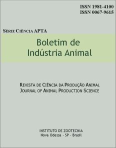Frequency and height of cutting in five cultivars of genus Stylosanthes SW
Abstract
A field plot experiment was carried Out at Seção de Agronomia de Plantas Forrageiras at Estação Experimental Central of the Institute de Zootecnia, in Nova Odessa, State of São Paulo, Brazil, from December 1979 to June 1981. It was evaluated the effects of three cuting heights (10; 20 and 30 cm) amd two frequencies of cuttinq: F1cut each 6 weeks during the €˜wet season€ (October to March) and each 9 weeks during the €˜dry season (April to September) and F2 cut each 8 or 16 weeks, during the €œwet season and the €˜dry season€™ respectively. It was evaluated the dry matter and total protein production per hectare of Stylosanthes guvariensis cv. Endeavour, S. guyanensis cv. Schofield, S. guvanerisis cv. IR -1022, S. capitata cv. CIAT-1019 e S. hamata cv. Verano. These species can be used in our environmental conditions. The experimental design was in randomized blocks and the ay out utilized was a factorial 5 x 2 x 3, for the factors: cultivar, frequencies and heights with three replications. Readings of emergency (number of plants/m) were recorded every week (after the twentieth day and last for 28 days). Cultivars Verano and IRI -1022 had superior and faster values than cv. Endeavour, but the cv. Schofield. CIAT-1019, IRI-1022 and Verano were similar in emergency. Readings of antracnosis disease evidenced that cv. IRI-1022 and Schofield were susceptible while cv. CIAT-1019, Verano and Endeavour were tolerant. During the €˜wet season€™, cut height at 10cm and F1 frequency related the best average of dry matter (D.M.) and crude protein (C.P.) production about 5,301kg D.M./ha and 972kg C.P./ha. At that time cv. Verano, Schofield and Endeavour were better than the others. In the dry season€, cut height at 20cm obtained the best average of D.M. and C.P. production (about 2,526 and 347kg/ha, respectively). At that time cv. Endeavour and Schofield were the best n dry matter and crude protein production.Downloads
Downloads
Published
Issue
Section
License
Os autores não serão remunerados pela publicação de trabalhos, pois devem abrir mão de seus direitos autorais em favor deste periódico. Por outro lado, os autores ficam autorizados a publicar seus artigos, simultaneamente, em repositórios da instituição de sua origem, desde que citada a fonte da publicação original seja Boletim de Indústria Animal. A revista se reserva o direito de efetuar, nos originais, alterações de ordem normativa, ortográfica e gramatical, com vistas a manter o padrão culto da língua e a credibilidade do veículo. Respeitará, no entanto, o estilo de escrever dos autores. Alterações, correções ou sugestões de ordem conceitual serão encaminhadas aos autores, quando necessário. Nesses casos, os artigos, depois de adequados, deverão ser submetidos a nova apreciação. As opiniões emitidas pelos autores dos artigos são de sua exclusiva responsabilidade. Todo o conteúdo deste periódico, exceto onde está identificado, está licenciado sob a Licença Creative Commons Attribution (CC-BY-NC). A condição BY implica que os licenciados podem copiar, distribuir, exibir e executar a obra e fazer trabalhos derivados com base em que só se dão o autor ou licenciante os créditos na forma especificada por estes. A cláusula NC significa que os licenciados podem copiar, distribuir, exibir e executar a obra e fazer trabalhos derivados com base apenas para fins não comerciais.













